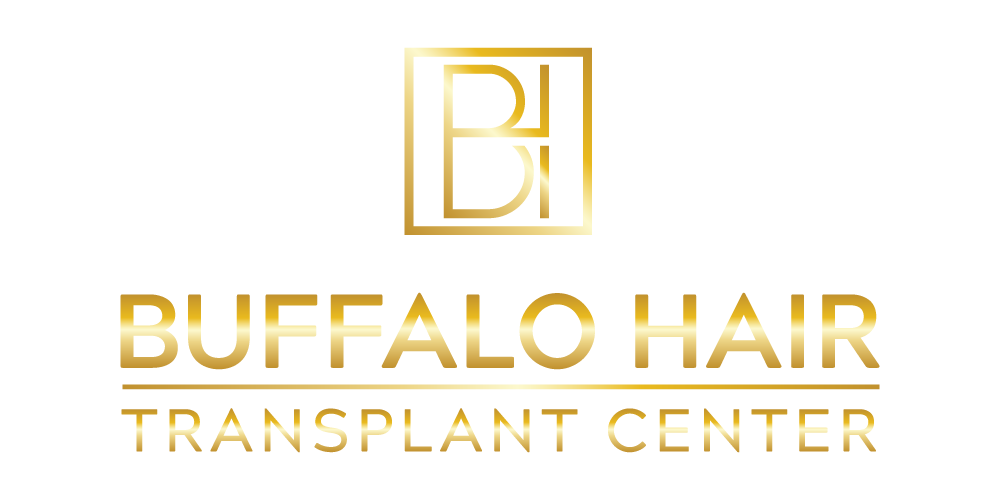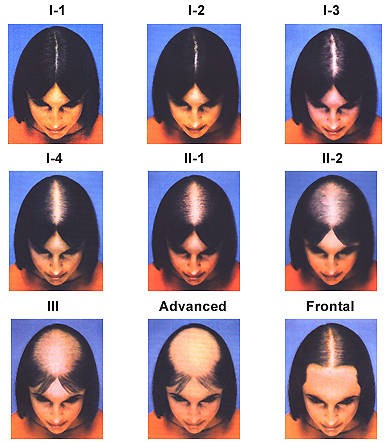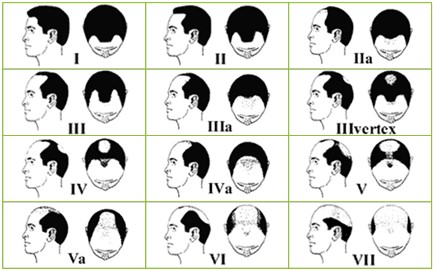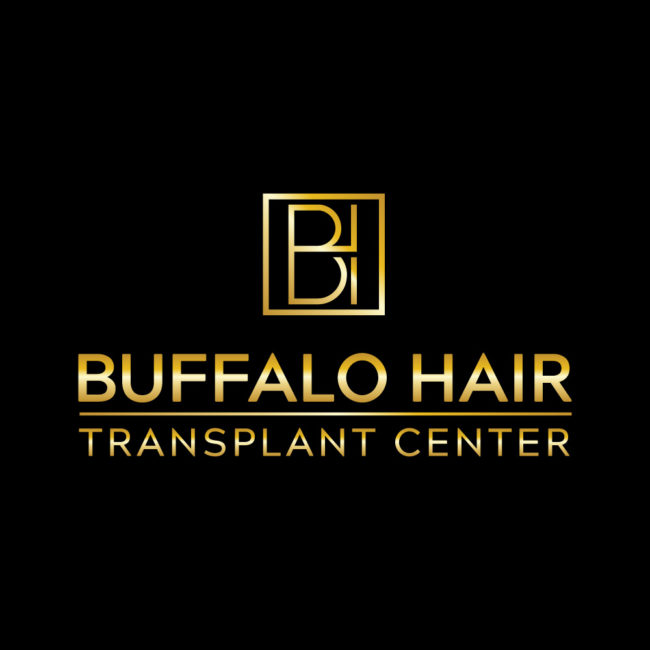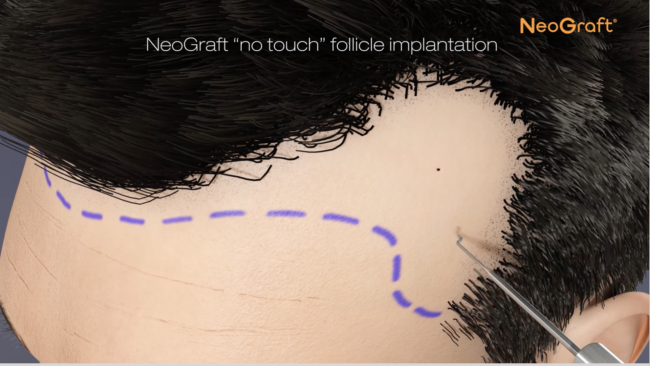Hair Restoration Terms | Buffalo Hair Transplant Center
Hair Restoration Surgery encompasses numerous Procedures & Terms:
- ALOPECIA: The medical term for baldness.
- ANDROGENIC ALOPECIA: The most typical pattern of balding whereby the balding pattern is controlled by hormones and passed along via heredity.
- ALOPECIA REDUCTION: A procedure that involves removal of a strip of balding upper scalp in the crown and vertex areas. The natural flexibility of the scalp is used to stretch the surrounding hairy scalp into place. It can be repeated in certain cases. See also “Scalp Reduction.”
- CROWN AREA: The area in the top/back portion of the head which contains a swirl or spiral pattern of hair growth. Also called the ‘vertex,’ it may be the first area where male pattern baldness is noticed.
- DONOR AREA: The fringe above the ears and around the back of the head where hair follicles are genetically programmed to remain intact and grow throughout life.
- DONOR DOMINANCE: The concept that hair follicles transplanted from the donor area will continue to grow in the recipient area.
- FEMALE PATTERN BALDNESS: A hereditary pattern of baldness found in women typically characterized by a diffuse thinning of hair and/or hair loss at the front portion of the scalp behind the frontal hairline. May or may not include a slight recession or thinning in the temples and only very rarely ends in complete baldness at the top of the scalp. Also called “Female Hereditary Hair Thinning.”
- FOLLICULAR UNIT: A follicular unit is a naturally occurring grouping of one, two, or three (and rarely, four) hair follicles found in the skin. The average follicular unit contains about 2.4 hairs.
- FOLLICULAR UNIT EXTRACTION (FUE or FOX): Follicular Unit Extraction is a method of extracting single follicular units, one at a time, from the donor site by using a tiny punch excision. A punch used to extract single follicular units is typically 1mm diameter or less.
- FOLLICULAR UNIT GRAFT: A graft consisting of a single follicular unit. In appropriate patients, artistic planning – in addition to the correct angulation, orientation, and positioning of follicular unit grafts – can yield an exceptionally “natural” appearance of the transplanted hair.
- FOLLICULAR UNIT MICROGRAFTING: A method by which large numbers of follicular units are harvested from the donor site (usually in a long strip or ellipse) and then microscopically dissected into grafts containing single follicular units.
- GRAFTING: A variety of procedures where hair-bearing skin is removed from the lower scalp at the back of the head-the “donor area”-and transferred to thinning or balding areas. The most popular varieties are micrografting (1-2 hairs) and minigrafting (3-8 hairs). A few surgeons selectively use round grafts which have 10-20- hairs each.
- HAIR ECONOMICS: A theory that states only a limited or decreasing supply of hair exists, but the demand for hair increases as balding patterns develop.
- HAIR FLAPS: Techniques to rotate large portions of hair from the sides and back of the scalp to the front and central areas of the head. Most effective when used with a tissue expander. See also “Scalp Rotation Flaps.”
- HAIR FOLLICLE: A strand of hair and its root which is extracted from the donor area and transplanted to the recipient area during hair restoration surgery.
- HAIR GRAFTS: Hair follicles that have been harvested from the donor area and are ready for transplantation into the recipient area of the scalp. The numbers of hair follicles per graft vary widely depending upon the transplantation technique used. A graft may contain a single hair follicle, a single follicular unit, multiple follicular units, or even 20 or more follicles (as in a large round graft).
- HAIR “PLUGS”: A slang term typically used to describe the large round grafts that were used more commonly years ago.
- HAIR TRANSPLANT: A surgical technique that transfers hair follicles from the donor area to the recipient area.
- HAIRLINE REFINEMENT: Hairline Refinement or “Hairline Correction” refers to the use of a variety of newer, more delicate grafting techniques to alter, camouflage or soften the “pluggy” looking results of older hair transplant techniques.
- MALE PATTERN BALDNESS: An inherited condition in men which is triggered by the hormone Dihydrotestosterone which causes gradual miniaturization (and eventual loss) of hair follicles. Starting anytime after puberty with a recession of the hairline and thinning of the crown areas, it can eventually lead to complete baldness at the top of the scalp. The areas around the sides and back of the scalp are not typically affected by male pattern baldness.
- MICROGRAFT: A graft containing 1 or 2 hairs, obtained from the donor area with a micropunch or sliced off from a round graft (see below). A micrograft is typically placed into holes made in the scalp with a microneedle or punch.
- MINIGRAFT: A graft containing 3 or 4 hairs (small minigraft) or 5 or 6 hairs (large minigraft). There are many variations of minigrafts derived from round grafts.
- MULTI-UNIT GRAFTS (MUG): Grafts that contain two or more follicular units in a single graft. This term replaces the older “minigraft”. In practice today, MUGs contain 2-6 follicular units per graft.
- MULTI-UNIT GRAFTING: Hair transplantation using multi-unit grafts. In practice, these grafts may be placed into small round holes, slots, or slits. This would always be in combination with the use of FUT in the same procedure.
- RECIPIENT AREA: Area where hair loss has occurred and hair follicles will be implanted during a hair transplant procedure.
- ROUND GRAFT: The first type of graft used in hair transplantation, a round graft has many variations. Harvested with punches of various sizes, a large round graft may contain many hairs (20 or more). The round graft is obtained from the donor site by surgical removal and may be used “as is” or may be sliced into smaller sections for micro-, mini- or slit grafts.
- SCALP REDUCTION: A procedure that removes bald scalp and brings the edges of hair-bearing scalp closer together. Scalp reduction is most often used in patients with crown baldness. See also “Alopecia Reduction.”
- SCALP ROTATION FLAPS: A type of procedure that involves the lifting and rotation of a strip of hairy scalp which is placed into an area of simultaneously removed balding skin.
- SLIT GRAFT: Hair obtained from a donor site directly or sectioned from a larger round graft is inserted into a slit made in the scalp by the tip of a scalpel blade.
- TEMPLES/TEMPORAL AREA: The two upper outer corners where the forehead meets the hairline. This is usually the first area where male pattern baldness is observed, causing the hairline to recede.
- TEMPORAL POINT: The two triangular shaped areas of hair located in the lower outer corners of the forehead, where the temporal hairline meets the sideburns.
- TISSUE EXPANDER: A reconstructive balloon-like device which can be used to enlarge hair-bearing scalp on the sides of the head, providing a larger supply of hair with which to replace the bald areas. Often used in hair flap techniques and scalp reductions.
- TISSUE EXTENDER: A device used to stretch scalp. Often used to speed up the process of scalp reductions by stretching the sides of the scalp that contain hair to achieve rapid elimination of bald areas. The tissue extender is temporarily inserted below the scalp and remains in place for a three-week period.
- VERTEX AREA: The area in the top/back portion of the head which contains a swirl or spiral pattern of hair growth. Also called the ‘crown,’ it may be the first area where male pattern baldness is noticed.
Neograft Hair Tranplantation FAQ’s | Buffalo Hair Transplant Center
What is NeoGraft™?
NeoGraft™ is a new automated device which facilitates the harvesting of follicles during a Follicular Unit Extraction (FUE) and implantation hair transplant procedure, dramatically improving the accuracy and speed over previously-used manual extraction instruments.
What is an “FUE” hair transplant?
“F.U.E.” or “Follicular-Unit Extraction” is an advanced, “minimally-invasive” hair transplant method which allows for the harvesting of individual follicles from the back of the head (donor area) without a scalpel or stitches, and therefore leaves no linear scar.
What are the main benefits of FUE over the traditional “Strip Method” or linear harvesting?
It is well-accepted that FUE transplants can heal faster and more comfortably than linear-harvest techniques which the physician uses a scalpel and removes a strip of scalp requiring stitches. With the minimally invasive technique FUE, the patient can return to work in a couple of days and once healing is complete, the patient has the option of wearing a very short haircut without the worry of a tell-tale linear scar. Without the need for stitches, downtime is shorter with fewer activity restrictions post-operatively.
What are some benefits of NeoGraft™ over manual FUE techniques?
The highly ergonomic mechanical NeoGraft™ device works as a natural extension of the surgeons’ hand, allowing for faster and more accurate harvesting of hair follicles. NeoGraft™ patients now reach their goal with less time in the procedure room or fewer FUE procedures altogether.
Who is a good candidate for FUE using NeoGraft™?
Patients who would like the option of wearing a very short haircut in the back or sides of their scalp, or those who want the least amount of activity restriction (e.g. athletes) after their hair transplant procedure, may be good candidates for FUE with NeoGraft™. FUE can also be used for ‘scar camouflage’ procedures for patients who have had prior “Strip” procedures, as well as for body hair transplants.
What are the major cost differences between FUE and linear-harvest hair transplant procedures?
The fee structure for FUE hair transplant procedures reflect the more detailed and intricate nature of those procedures compared to those performed with a linear harvest strip method but in most cases is very similar in pricing.
Are the final transplanted ‘results’ any different with FUE/NeoGraft™ than those achieved with linear harvesting?
Results are similar. FUE procedures, by default, yield grafts that contain mainly one, two, three, or four follicles called “follicular units.” Strips or linear harvests, are removed from the back of the scalp and are then microscopically dissected by a team into grafts of one, two or three follicles, would also yield similar ‘follicular-unit’ grafts. Provided that in each case the grafts are implanted with care, artistry and precision into the recipient area, the final transplanted results with FUE would be similar, if not identical, to those accomplished with a linear harvest. The difference is not in the area of hair growth, but how the donor area is harvested either by a strip of scalp or by small individual graft extractions. Using the FUE Technique, leaves no linear scar.
Is FUE/NeoGraft™ suitable for both men and women?
Yes. Because FUE/NeoGraft™ is a minimally-invasive procedure, it is a viable option for both men and women looking to restore their own living and growing hair with transplantation.
Do I have to get a total ‘buzz cut’ to have an FUE/NeoGraft procedure?
No, if your hair is long enough, harvesting using the FUE/NeoGraft can be done by shaving small areas which can be covered by your other, existing hair.
Am I a good candidate for a procedure using FUE/NeoGraft?
The best way to determine whether you are a candidate for hair transplant using FUE/NeoGraft is a one-on-one consultation with your doctor.
When should I expect the most swelling?
Your body’s immune system kicks in approximately 3 days post hair transplant where you will notice the greatest amount of swelling lasting up to 7 days.
When will I see results?
You will experience normal early hair loss “shedding” before you see hair growth starting at 4 months. Ideal permanent results are not seen until 9 -12 months. Hair growth takes time, regardless if it’s your own natural hair growing or transplanted hair.
What are Donor Sites?
Donor sites are areas of permanent hair located on the back and sides of the scalp. These follicles are resistant to hormonal hair loss (DHT).
Will my Donor sites look noticeably thin or bald?
No. Although the donor sites will thin the density of the area, 50% hair density in that area is more the sufficient to provide ideal coverage. Importantly the automated suction performed by the Neograft hair transplant device, strategically pulls follicles in a random pattern to prevent follicles from being removed all from one area, eliminated the illusion of patchy hair loss.
How long before I can wash off the scabs?
For 7 to 10 days, avoid direct pressure from the shower head, use spray on shampoo. After 10 days, you can wash your hair using bio cleansing shampoo and thickening conditioner and wash of the scabs. Avoid aggressive rubbing.
Why am I losing transplanted hair?
It is both normal and common. The first Stage post-transplant is called the Catagen phase where ‘shedding’ will occur. The second stage is called Telogen phase or resting phase that last 3 months. 4 months post-transplant is when you will notice growth of new follicles, known as the anogen phase.
Is the procedure painful?
No, Neograft method uses local anesthesia during the procedure so that the area is numb. Post procedure, pain medication is prescribed as needed.
What are the risk of neograft transplant?
This is a minimal invasive procedure. Pain is well controlled with local anesthesia and post op pain medication. Risk of Infection is controlled with preventative antibiotic prescriptions.
How long do I leave the bandage on?
The bandage can be removed the following day, unless informed otherwise.
How do I dry my hair?
During the 2 weeks following your transplant it is advised to pat dry, avoid rubbing or hair dryers to prevent damage to the new follicles for 4 weeks after transplant. When using the dryer, use a low heat setting.
How do I cut my hair prior to the procedure?
Men – are advised to shave the hair down to the skin along the back and sides of your scalp. This will allow the technician to determine direction of hair growth accurately. It is advised to cut your hair within 24 hours of procedure.
Women – are advised to cut hair in shaved strips based on how many grafts are required for the transplant. Shaving is recommended within 24 hours of procedure.
Both men and women are recommended to keep longer hair to cover up areas of shaving to maintain discretion of procedure.
When can I cut my hair next?
You may get another haircut 2 weeks post procedure.
Coloring your hair?
If you wish to color your hair perform coloring 3 days prior to procedure. After the procedure, it is recoomended to wait 2 months until you can color your hair again. Semi-permanent color is reccomendded until the 3 month period.
When can I use hair products like gel, mouse, hair spray?
It is advised to wait 3 weeks after the procedure before you use any products on the hair and scalp.
How long before i can work out?
Avoid unnecessary perspiration or strain to the newly transplanted follicles. It is advised to take 10 days off from vigorous exercise.
When should I have my follow-up?
1 week post transplant.
Can I smoke and drink?
Smoking and drinking can negatively affect your transplant. It is advised to stop smoking pre and post transplant to improve the healing process and recovery time. Drinking is advised to be discontinued 3 day prior procedure and for 1 week post, again to improve your healing process.
When can I wash my hair?
You can wash your hair the next day. The back of the scalp can be scrubs. The transplanted area should not have direct contact with water but be rinsed from back to front with a cup, do not rub grafts for 10 days. Apply polysporin for the next 2 days to hassen healing of scabs on the back.
Can I comb my hair?
You can use your fingers or a wide tooth comb, avoid contact with the grafts.
Neograft Hair Transplant Pre-op & Post-op Instructions | Buffalo Hair Transplant Center
Before Surgery
Please arrive at the office no later than 7 am. In the event that you may require medication, it is required that you be dropped off and picked up after your procedure.
- You may wash your hair the morning of your surgery with your regular shampoo.
- Do not drink alcohol or caffeine the night before or the morning of your procedure.
- Eat a light breakfast prior to arriving for your procedure.
- Wear a button down shirt or something easily removable.
- If medications were given to you by your physician prior to the procedure, please bring them with you on your procedure day.
- Upon your arrival to the practice, please complete your medical questionnaire and sign your consent forms.
- Speak with your physician about any medications you are currently taking.
- Prior to your surgery, avoid any supplements or medications that could cause blood thinning such as, asprin, Ibuprofen (Advil/Motrin)..etc.
- Pre-operative photos will be taken for your chart only unless other arrangements have been made.
- Please consider what hairstyle you will wear for your procedure. The donor site will need to be shaven down using a 1 or 0 guard.
- Smoking is strongly prohibited as this will delay your wound healing time.
- If you color your hair, it is recommended that you color your hair a few days before your procedure. After the procedure, you must wait 6-8 weeks before you can color your hair again and a semi- permanent color should be used instead of a permanent hair color that may cause damage to your new grafts. Permanent hair color can be used 3 months post op.
- Please feel free to ask as many questions as you like. We want you to be well informed.
During the Procedure
- You may bring your own audiobooks or music as long as it is appropriate for everyone.
- At any time during the procedure you may get up for breaks, such as restroom breaks or a brief stretch.
- We will break for lunch if your procedure is scheduled for the entire day. Please discuss lunch arrangements with the practice staff prior to your procedure.
- Friends and family are not allowed in the surgery room when the procedure is being done, however, they will be allowed to visit and check on your progress. By having others in a surgery suite lends to a non-sterile environment and is not encouraged by OSHA.
After Surgery
- You will be given all required prescriptions, medications and detailed post-op instructions. Please follow those instructions carefully.
Should you have any questions concerning any aspect of your procedure, please call the office.
What to expect Post-Op NeoGraft Hair Transplant? | Buffalo Hair Transplant Center
24-48 Hours Post-Op:
Avoid all contact to donor site and newly implanted grafts.
- No washing scalp or full stream water pressure from shower head on newly implanted grafts.
- No alcohol.
- Consult with your physician before resuming any medications, including vitamins and herbal supplements.
- No ibuprofen (Advil/Motrin), aspirin or blood thinners of any kind. Speak with your physician to see if a prescription strength medicine is needed.
- Do NOT remove pressure bandage from back of scalp. Discuss with your physician about the best time to remove the bandages.
- No hats, caps or beanies.
- No activities that cause excessive sweating such as running, weight lifting or intense workouts for the first 14 days.
- Avoid excessive sun exposure to grafts for the first 14 days.
For Sleep:
By following the directions below, you will control swelling in the forehead/brow region:
Frontal Hairline Restoration:
- Sleep in an elevated position for 2 nights following a procedure. It is best to use 3 pillows under your upper body or sleep in a recliner.
Crown Restoration:
- Sleep with a neck pillow or rolled up towel under your neck.
For Minor Bleeding:
In occasional instances, minor bleeding may occur from the transplant site and/or donor area.
- To control bleeding, apply gentle, but firm pressure on the area for 5-10 minutes with a dampened gauze pad. Press only, do NOT rub.
After 48 Hours Post-Op:
The donor site should now be closed up and healing. Your physician may suggest removing the bandage at this time.
- You may gently wash your entire scalp including the sides and back of your head by using CopperK Shampoo Spray or Johnson and Johnson Baby Shampoo, and rinsing it by gently pouring luke warm (NOT hot) water from a cup over your scalp.
- Avoid direct water pressure on newly implanted grafts.
- You may massage the donor site, but do NOT touch the recipient area with your fingers for 7 days post op as this may cause the grafts to dislodge. After 7 days you may begin to wash your hair normally.
- Do NOT use any hair products NOT recommended to you by your physician for the first 14 days.
- As your scalp begins to heal, you will start to see scabbing on the donor and newly implanted graft site.
- A very loose fitting hat/cap that does not come in contact with the grafts may be worn.
- After bandages are removed, apply Bacitracin ointment over the donor area at least 3 times a day for the next 3-4 days to keep it moist.
- In between Bacitracin use, CopperK Scalp Cream should be gently dabbed on the donor site to help heal scabs.
72 Hours Post-Op:
Swelling is a part of the healing process and typically occurs on day 2 or 3 post-op. It usually disappears in 5-7 days.
- Do NOT apply ice directly to graft area.
- For swelling around eyes and forehead, apply ice pack to eyebrow area and below.
- Do NOT use hot compresses.
2 Weeks Post-Op:
After 2 weeks, or once the scabs have fallen off:
- Minor workouts can be added into your daily regimen.
- You may use spray sunscreen or an adjustable fitted hat, if you will be out in the sun for more than 30 minutes.
- Check with your physician before resuming Rogaine 5% foam. (Typically 1 month) Propecia can continue to be used.
Additional Information:
Scabbing or Itching at donor and transplant site:
- Do NOT PICK or SCRATCH at these scabs as this can endanger healing and could cause scarring or infection.
- Scabs will naturally fall off within 2 weeks and may contain small hairs. Do NOT be alarmed as this is normal. The hair bulb remains in the skin.
- CopperK Calming Spray will reduce discomfort, itching and inflammation. This can be used as needed, up to 2 times a day for 2 weeks post op to keep the scabs moist.
- To reduce itching, you may also use a diluted saline solution by pouring the solution into a spray bottle. Spray onto irritated area up to 2 times a day for 2 weeks to keep the scabs moist.
- It is recommended to use the CopperK Calming Spray or a diluted saline solution on the irritated area immediately after the shower.
Hair Coloring:
You must wait 6-8 weeks before you can dye your hair. It is recommended that you color with semi-permanent dye as to not damage your grafts.
